|
|
|---|---|
Edition 72 - August 2014 Published at Quepos, Canton of Aguirre, Province of Puntarenas, Costa Rica (© Copyright 2014 - All Rights Reserved) |
Golden Gringo Chronicles E-Books and Hard Copy Novel Now Available!
A narrative version of the Golden Gringo Chronicles is now available as a trilogy of E-books in formats compatible with virtually all electronic platforms. Click on Part Number above for E-book sample downloads or click the price above right for purchase. (The best price is on Part 1; it's FREE)
The story of the Golden Gringo Chronicles is also available as a hard copy novel of 192 pages available through Amazon and all major online retailers. Amazon link: GGC, the Book. (Kindle Edition available) Follow GG through the first six years of his odyssey in making the decision to retire in Costa Rica, overcoming the trials and tribulations of moving and obtaining residency there and the fun and experience of actually living in Ticoland. Ride along with the Golden Gringo as he learns about the rich, varied culture of Costa Rica, the incredible bio diversity, the charming nature of the Costa Rican people and the ease with which a sometimes clueless ex-pat can assimilate into a small southwestern town on the Pacific coast. Whether you are already a Costa Rican resident, someone contemplating a move here or just a traveler who enjoys different cultures, you will find the Golden Gringo Chronicles interesting, entertaining and informative about Costa Rica. |
Broken News
(All the News That's Fit to Reprint)
Olé Ticos - Ya!
The Chronicles reported last month on the fine performance of the Costa Rican futbol team (called locally "La Sele", meaning the selection) when they survived their three qualifier games at the World Cup. In the qualifiers, they beat Uruguay 3-1, Italy 1-0 and tied England 0-0. They ended number one in points in Group D and advanced to the group of sixteen, a status they had achieved only once before, some twenty years ago.
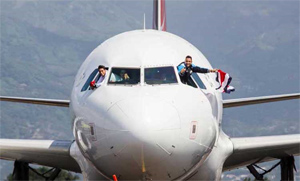 |
Brian Ruiz and Keylor Navas of "La Sele" Arriving Back Home at San José Airport (Guess They Don't Have FAA Regs Here) |
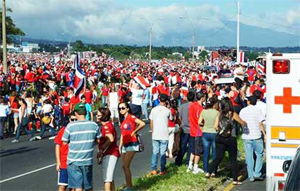 |
Part of the Welcoming Crowd at Juan Santamaria Airport |
At the group of sixteen level, the tournament becomes a single elimination affair and each game must be settled by overtimes (2 at 15 minutes each) or, failing resolution there, by penalty kicks in which those poor goalies have to defend that large goal against up to five players, one at a time of course.
Subsequent to the qualifiers, the Ticos went on to play Greece in the group of sixteen, winning by a hair (1-1, 5-3) after two overtime periods and surprising everyone. The pandemonium in Quepos-Manuel Antonio mentioned last month after beating Italy resumed; horns, shouting and display of the national flag could be heard and seen everywhere. The win over Greece put them in the group of eight or quarter finals for the first time in their history.
The Ticos drew the Netherlands team next and the Ticos suffered their first lost of the tournament, sadly by another squeaker (0-0, 4-3) on penalty kicks, after the two overtimes were exhausted. The silence around town was deafening, except for the muffled crying of about half the populace. I'm not kidding, that's the way it was.
Having watched the game with Greece along side my landlord and his family (mom, dad, the three boys and grand pop) I came to understand the emotional strain these games put on people. Non-soccer fans may not understand that the low scores are not what it's about - it's the intensity of the game that gets you. There is very little stop time; they play two 45 minute periods and the referee can extend the periods by what he judges was unnecessary delay time during the period. For example, in the Costa Rica/Greek game, the referee added two minutes to the first period and five to the second and there were two overtime periods. So they played 45 + 2 + 45 + 5 + 15 + 15 or 127 minutes (that's two hours and seven minutes) before they got to the penalty kicks that settled the winner. Grueling work, on the players and fans alike.
 |
President of Argentina Cristina Fernandez Kirchner |
After the quarter finals, the balance of the tournament went quickly to Germany who first stymied Holland's hopes in the quarter finals and then bludgeoning the host Brazilians 7-1 in the semi-final. In the final game for the cup they outlasted the Argentine team 1-0, scoring the game's only goal far into the second period and setting off an explosion among the German fans and heavy sobbing among the Argentines.
The Germany/Brazil game produced some new World Cup firsts. As reported in the international press: "Germany's goal total was the most ever by one team in a World Cup semifinal, while Brazil matched its worst-ever margin of defeat and allowed seven goals for the first time in 80 years. Brazil also lost its first official competitive match at home since 1975." Tranquilo, amigos.
A friend who lives in Buenos Aries says that after the Argentine loss, talk spread quickly that focused on forcing the current lady President, Cristina Fernández de Kirchner, to resign. Futbol is serious business in Latin America.
The Costa Rica team returned to a hero's welcome at the airport and enjoyed a victory parade through downtown. Estimates were that more than 500,000 people turned out to greet them, including Sr. Solis, the President of the Republic. That's more than 10% of the country and about 20% of the entire central valley area.
Reports are that over $14 million was Costa Rica's share of the World Cup purse and that it was distributed not only among the coach (he got $1 Mil) and the players of La Sele but amongst other teams throughout the country and also to training centers where the kids and future stars learn the ins and outs of the game.
Welcome home amigos!
¡Buen Trabajo!
Solis Trying
Continuing with the promise of frugality made at his inauguration, President Luis Guillermo Solis issued a directive this past month via his Finance Minister that directs agencies of the government to: (1) keep 85 percent of currently vacant positions as they are, hoping to save around $40 million; (2) cuts 20 percent of expenses made on luxury or nonessential items; (3) freezes salaries for administrative heads and
(4) requires review of all building contracts for all buildings rented by public agencies in order to minimize rental costs. The goal is to save $77,000,000annually.
While this is a noble and encouraging attempt to rein in some government costs, $77 million is only about one half of one percent of the budget and the country continues to run at a total forty per cent deficit. Long way to go amigo, but keep trying.
 |
 |
In the international investment front, results continued mixed. StarTek, a "business process outsourcing service company" (read third-party customer service contractor) headquartered in Denver, Colorado announced it was closing its call center in Heredia and terminating its 500 employees. Only five months earlier, StarTek had announced expansion of its operation in Honduras. The gist? The work moves to Tegucipalpa.
On the positive front, Sr. Solis announced that Proctor & Gamble will soon add some 300 employees at its Forum 1 business center offices (its "Planning Center", whatever that means) located on the autopista west of San José. Solis had made a swing through the U.S. shortly after his inauguration and attracted several other new firms to invest in Costa Rica. Good work, Senor.
Nevertheless Exports Are Up
Despite the recent loss of the Intel manufacturing plant, a business that has accounted for up to 20% of Costa Rican exports in the past, exports for the first trimester of this year rose 4% over the same period last year. Also reported: "An estimated 841 businesses exported their products to the United States during the first semester. And more than a thousand Costa Rican companies exported to neighboring Central American countries, according to the statistics. In analyzing the data by industry, the country has seen a significant 5.5 percent increase in agriculture, livestock products, and fish exports. In addition, sales of medical devices went up 16 percent, electric cables by 14 percent, pineapple by 12.7 percent, banana by 7.4 percent, melon by 18.8 percent".
Tour operators and their Chamber of Commerce are reeling from new proposals and railing against new taxes being imposed on the recreation industry. Section C of the general tax code specifies that sales tax (13%) be applied to night clubs, social centers, centers of recreation and similar.
A new interpretation now broadens the taxable list to include activities such as canopy tours, nature walks, rafting and SCUBA diving. This broadening was a result of a decree issued by the environmental ministry, a leftover decree from the chinchilla administration. In addition the ministry wants to apply the tax retroactively to the beginning of the law and is looking to collect some 384 months in back taxes. (Can't see that happening unless the government wants to drive most of the small operators, who are most of the industry, out of business - Ed.). At press time, President Solis was meeting with the tax ministry or resolve the issue.
Meanwhile, on April 30, the environmental administration increased entrance fees on national parks and other areas under its control. Parque National Manuel Antonio went to $16 for a non-citizen or non-resident. After applying sales tax, this becomes $18 which is up 80% from a few years ago.
Rumble Talk
(Shaky Happenings On or About the Pacific Rim)
Rumble, rumble, rumble, rumble, rumble, rumble, rumble, rumble, rumble, rumble, rumble, rumble, rumble, rumble, rumble, rumble, rumble, rumble, rumble, rumble, rumble.
 |
What, Me Worry? |
That's the extent of rumble talk for this month. Well, OK, we've had a few quick rollers about 4 on the Richter but that's nothing. All continues to be quiet on the western front but we're left wondering, are things abuilding? Who knows? It's not disappointing to have no serious action, just perplexing.
Here are some links to past Chronicles articles on Tico tremors:
The 6.3 Earthquake In San Jose: Edition 6 January 2009
Richter Scale Explained: Edition 20 - Earthquake Chart
Earthquake Advice: Edition 33 - How to Beat a Terremoto
The 7.6 Earthquake, Surviving: Edition 50 - Terremoto Terror
The 7.6 Earthquake, Aftermath: Edition 51 - More on the Big One
| Check Out Recent Earthquakes Around the World Posted by the U.S. Geodetic Survey: Today's Quakes |
|---|
Tico Temperance
(Selected Mammals that Drink in Ticoland)
Living in a resort area like Quepos/Manuel Antonio one tends to believe that drinking is a serious pastime, at least when one sees all these people on vacation frequenting local emporiums. This belief is reinforced by the presence of six or seven dozen bars that can be found in an area with a permanent population of less than 10,000 souls.
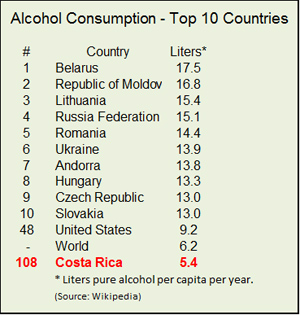 |
Top Ten Alcohol Consuming Countries & U.S./Costa Rica Comparison |
So it may come as a shock to some, like it did to GG, that per capita alcohol consumption in Costa Rica is below the world average (even after averaging in the negligible rates in Muslim countries that contribute to the world number). The Tico rate is also only slightly more than half the U.S. rate. The table to the left from Wikipedia tells it all.
The eastern European countries surrounding and including Russia, those countries we used to call the Iron Curtain countries only a few decades ago, dominate the top ten positions as alcohol consumers. Their alcohol consumption rate is two to three times the world average in the eastern European block.
The U.S. comes in at #48 while Costa Rica displays a paltry #108. This ranking is for approximately 170 countries for which data is available. Costa Rica, #108, who'd a thunk it?
One has to wonder how much the national rate is increased by visitors and tourists? For example, as measured by internationals tourist arrivals, the United States receives 22,300 tourists annually for every 100,000 inhabitants whereas Costa Rica receives just about 52,000 tourists for every 100,000 inhabitants; Costa Rica has about 2.3 times the visitor rate and about 40% of the tourists here come from the U.S. Since both the U.S. and world rates are higher, visitors must have a strong upward affect on alcohol consumption here. That suggests that the intrinsic rate in the country is even lower.
Within the seven countries of Central America, Costa Rica ranks as the third highest behind Belize (8.5) and Panama (8.0). From the raw data, one would lean towards concluding that the rate amongst countries increases with the general level of prosperity in the country, but the European experience would speak against that logic. Most of the European countries are "developed", at least relative to Central America but they have some of the highest alcohol consumption rates.
A headline in a recent daily electronic English newsletter here stated that the World Health Organization had found that just about half of Costa Ricans refrain from drinking altogether.
 |
(Not So ) Good Morning |
If we use the fact that about 1/3 of the population is under the age of 15 (some at this age or younger drink, but it's relatively negligible under that age), then the number of people consuming alcohol products is 4,500,000 (total population) x .67 x .5, or just about 1.5 million people here are consuming alcohol. And they are consuming 4,500,000 x 5.4 = 24.3 million liters of pure alcohol or about 16 liters per imbibing Tico. (One liter = 1.06 quarts).
That individual rate is equivalent to 445-600 milliliter bottles of beer (@ 6% alcohol) or about 142-75 centiliter bottles of wine (@ 15% alcohol) or about 45-86 proof, 28 oz bottles of whiskey. Anyway you count it, sounds like a lot of hangovers to me. (Sorry about all the numbers, the engineer germ inside me will never be killed)
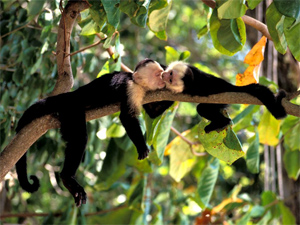 |
"Come on Babe You're Almost Home, Mommy Will Take Care of You" |
It's not just humans that over-imbibe. Wherever there is fruit or a living plant with sugar in it (sugar cane stalks, for example), there is the potential for fermentation. Animals consume the fermented fruit and enjoy the inebriation, at east for awhile and monkeys are no exception. One recent study concluded that monkeys have about the same rate of alcoholism as humans (no surprise there, considering out joint history).
It's well documented that Vervet monkeys on St. Kitts in the caribbean started on fermented sugar cane centuries ago but now specialize in stealing drinks from tourists on the beaches and at bars. Studies show that juvenile Vervets also tend to drink more than adults (ah, more misspent youth, just like GG).
And there are examples from around the world of a variety of animals that enjoy inebriation. In some cases, animals are known to use naturally grown narcotic materials as well. Take the wallabies for example. On the island of Tasmania near Australia, wallabies take advantage of the legally grown poppy fields that produce much of the world's pharmaceutical grade opium. Says an official there: "We have a problem with wallabies entering poppy fields, getting as high as a kite and going around in circles." (Hmmm, maybe they were the first Tasmanian devils?).
 |
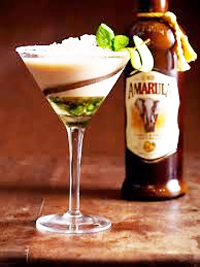 |
 |
 |
Elephant Off the Wagon |
In Africa, many animals including elephants, giraffes and smaller ground animals wait for the fruit of the Marula tree to ripen and fall to the ground well fermented. Actually the giraffes are so tall, they can reach the fruit directly.
The elephants use another method, they simply butt the tree with their heads bringing into play their three-ton bulk to easily sway the tree and dislodge the fruit. These enormous pachyderms have been seen swaying back and forth while walking after eating Marula fruit; in some cases actually falling over.
Not to be outdone, local homo sapiens in Africa have created a liqueur from the fruit of the Marula tree called, unsurprisingly, Amarula. The label contains a picture of an elephant (see bottle left).
Books could and have been written about many other animals around the world imbibing fermented fruits and various forms of narcotic-laced plants, to wit:
|
So, if you happen to be a mammal visiting Costa Rica, please be careful about eating any overripe fruit. It could lead to a headache. The fresh kind of fruit, of which we eat gigantic amounts daily in Costa Rica, is no problem.
¡Pura Vida!
No Hangover Here
(The Woodpeckers of Costa Rica)
 |
OK, I'll admit at the outset that GG is probably a closet bird watcher. I love the way birds soar through the air, although I have to admit I hold a resentment against seagulls, having spent so much time at the beach and received the effect of their dive bombing more than once. They don't seem to return the respect I give them.
 |
Growing up in the Northeastern U.S. I was familiar another kind of bird, the woodpecker. But it seemed as if there was only one kind; there may have been more than one type but I don't remember them (except for Woody of course).
Costa Rica, being Costa Rica, has at least 16 distinct varieties of woodpecker. It has many varieties of all kinds of birds. Wikipedia reports that "894 bird species have been recorded in the country (including Cocos Island), more than in all of the United States and Canada combined".
In addition to the regular sized woodpeckers in Costa Rica, there is also a group of mini-woodpeckers called the piculets. The size of Costa Rican woodpeckers ranges from the Lineated Woodpecker at a length of about 34 cm (13+ inches) to the Olivaceous Piculet at 9 cm (3 1/2 inches). Just a sampling of the diversity in Ticoland woodpeckers is shown below.
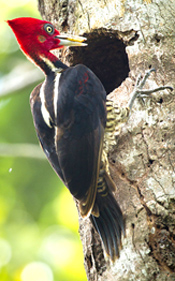 |
Pale-Billed Woodpecker |
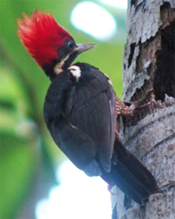 |
Lineated Woodpecker |
 |
Olivaceous Piculet |
 |
Golden Olive Woodpecker |
 |
Hoffman's Woodpecker |
Probably the last thing a mammal or bird with a hangover would do is pound their head against a tree, repeatedly and hard. So maybe it's safe to say the woodpeckers of Costa Rica, and elsewhere for that matter, are unlikely to be imbibers like the monkeys reported above. So, why do they peck?
Three reasons in particular say ornithologists. Firstly, they get food. by dislodging wood-boring insects, grubs and ants that burrow into the tree's wood fibers. They don't eat the fibers, though they can sometimes damage a tree by pulling apart a lot of fibers. It's not all about the insects though. Woodpeckers will also eat large amounts of tree sap, nuts, seeds, berries and fruit.
The next reason they tap is to attract a mate. No one so far has figured out if it's just a general signal to indicate they're in the area (not much else sounds like a woodpecker pecking, eh what?) or there is some kind of signaling going on.
The last reason woodpeckers peck is to mark their territory. Again, if there is a code inherent in this activity it's not yet understood by scientists.
Woodpeckers pound at a force equal to 1,000 g's or 1,000 times the force of gravity. No human could survive that kind of force. The Air Force estimated from tests in the past that humans could not withstand forces greater than 46 times the force of gravity although some race car drivers have reportedly survived greater than 100 g's in their crashes.
So why don't woodpeckers hurt their head or scramble their brains, pecking away at the rate of 12,000 times per day? Because, say scientists, mother nature has evolved them into having a special head with a very thick cranium. Also, the brain fits much more snugly into the skull than in a human's so it's not as easily shocked. Another interesting fact is that the woodpecker's brain is mounted 90 degrees to the skull so it can absorb shock over a greater area (less force per square inch).
And then there's the fact that a woodpecker's brain is only 2 grams or less than 1/10th of an ounce. That's about the weight of two paperclips. A human brain on the other hand is about 1,400 grams (3.1 pounds or almost 50 ounces). Humans are constructed for thinking, not pecking on wood.
So we'll keep thinking and, I presume, the woodpeckers will keep pecking totally unaware of their unique physical makeup while we try to become more aware of ours.
¡Solo Bueno!
Exposing the Ex-Pats
(Where Do All Those Gringos Go)
Some press reports indicate the number of U.S. ex-pats living abroad has increased from 2.7 million to 4.3 million in the decade ending in 2010, an increase of nearly 60%. The U.S. population during that time increased by slightly less than 10%. Other estimates put total ex-pats worldwide as high as 6.3 million (source: AARO - Association of Americans Residing Overseas). The higher number would include uniformed military personnel.
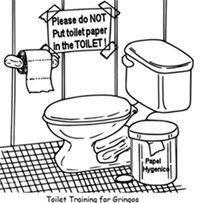 |
Data for the number of ex-pats living in various countries is available but its accuracy is debatable. That's because what truly constitutes a "resident" is a matter of interpretation both to the individual and to the people doing the counting. In Costa Rica for example, if you have a cédula (official residency document), you are probably counted by those doing the counting. If you don't, you probably get missed. So, an accurate count is problematic because of de facto situations, people who are actually living here but hold no cédula.
As a result of the difficulty in counting, the estimates of the number of ex-pats living in another country are always given with a broad range. The number for Costa Rica for example (41,141) is given within a 95% statistical accuracy range to be 25,882 to 65,394. GG would guess the number is closer to the higher end because of the reasons cited above.
But what about the person who comes here for a longer than three-month stay (the normal visa limit) and suffers the indignity of running to the border every three months to renew their visa. Are they residents, part-time residents or none of the above? And what about the significant number of people who are de facto residents, i.e., they're actually living here but choose to do the border run every quarter rather than obtain residency or perhaps they are "en tramite" (in process) awaiting residency approval. We call such people "perpetual tourists". These people (and I was one of them for over two years) are not likely to be found registered at the U.S. Embassy or in the count.
The U.S. Government has a vested interest in knowing how many of its citizens are resident overseas; they want to tax you on worldwide income to get as much tax out of you as possible . The U.S. is only one of two countries around the world (Eritrea is the other) that taxes worldwide income instead of taxing territorially, i.e., the rest of the world taxes income only when you earn the income within their territory. I remember this being a problem for the company that I worked for when I lived in Brussels. The company had to pay income tax on our salaries in both the U.S. and Belgium, making using U.S. Citizen employees (often ones with specialized talent for what we were doing) very expensive.
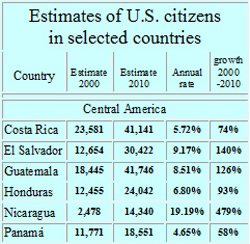 |
(Est.) Ex-Pats in Central America |
The (estimated) number of ex-pats currently living in Central America is shown in the table to the left. Also shown are the growth rates for these countries during the decade ending in 2010. Costa Rica had the lowest growth rate for U.S. ex-pats during the previous decade, but is still very close to a tie for first place in the actual number of ex-pats resident here, just slightly behind Guatemala. Nicaragua had by far the fastest growth rate but on a very small base.
There are seven countries in Central America but only six are shown in this table. Data for Belize was not included, probably because of its very small population (about 250,000) and ex-pat count (<2,000).
Which brought to my frustrated engineering mind that it might be more relevant to relate the number of ex-pats to the countries population. Forty-one thousand ex-pats in a country the size of Costa Rica (4.7 million people) should have more of a presence than the same number in a country like Guatemala with a population more than three times that of Costa Rica (15.1 million).
So I found another table of the top 45 countries based on the absolute number of U.S. ex-pats and re-cast them as a "density" or number of ex-pats per million population. The raw results are in an addendum to this edition and can be seen here HERE if you'd like.
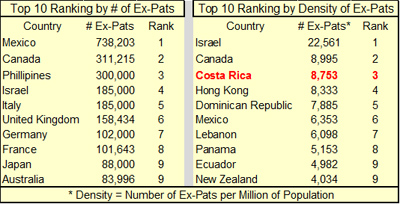 |
The top ten by absolute number and also by density are shown on the table to the right. It's understandable that the two U.S. border countries, Mexico and Canada would have the most number of ex-pats but when density is taken into consideration the results are quite different.
With density as the measure, Israel moves to the number one spot, which surprised me a bit until I remembered there has been quite a diaspora from the U.S. to Israel in the last fifty years. Canada still comes in as the number two spot, which is not surprising considering the proximity and similarity in customs, language and traditions.
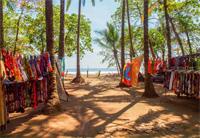 |
Not Very Dense Here... |
The density figures show Costa Rica as #3 and the leading Latin American country on this basis. The other interesting fact is that Latin American countries were represented only by Mexico in the Top 10 absolute number ranking but increased to five for the density rankings (Costa Rica, Dominican Republic, Mexico, Panama and Ecuador). GG can report from discussions with people who've lived in all five of these countries that gringos are treated pretty well in all of them.
Another way to look at it is that higher density or higher exposure of ex-pats in a country helps the host country to more effectively deal with foreign residents. That also should be good for the ex-pats.
The trend towards a larger number of ex-pats in Latin America is expected to continue and maybe even accelerate. This will be true if for no other reason than great numbers of gringos are reaching retirement and have a penchant for the warmer climates in their later years (I can second that motion).
It gives a new twist and meaning to global warming; moving towards it as I get older.
¡Pura Vida!
Travel Quote of The Month |
“What you’ve done becomes the judge of what you’re going to do, especially in other people’s minds. When you’re traveling, you are what you are right there and then. People don’t have your past to hold against you. No yesterdays on the road.” |
What's-in-a-Word
Borracho (bō - rah - chō)
This is the Spanish word for drunk. It's used as either an adverb to describe someone who is currently inebriated or as a noun to describe someone who is perpetually in that condition. I presume that if you were a small drunk monkey, you could be called a borrachito.
ROMEO Corner
(Retired Old Men Eating Out)
Claro que Sí @ Si Como No
Location: Top of Manuel Antonio hill on the ocean side of the road across from the Hotel Byblos and
next to the "Regaleme" gift shop (in a future life, places like this will have an address like 1148 Manuel Antonio Road, but for now the current lack of street names and addresses is quaint).
Hours: 2:30 PM to 10 PM, Monday through Sunday.
Parking: Some, but limited in front of the restaurant.
Contact: Tel.: 2777 0777; Email: info@sicomono.com; Website: http://www.sicomono.com
Reviewing ROMEOS: Roberta W., Bobby S, Brian M., Davis H., Bob N.
To Review Our Rating System and Procedure, go here: R.O.M.E.O. Rating System
The owners here have an impish penchant for playing with words. Si Como No is a Costa Rican colloquialism roughly translated as "Yes Like No" or "Yes As No" depending on how you want to use it. Claro que Sí is another colloquialism and is kinda like saying "Yes, Sure" or "Yes, Right".
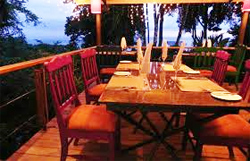 |
Claro que Seafood Dining Room |
The ROMEOs previously reviewed a restaurant at Si Como No in November 2010. At the time I'm not sure if we realized there were and still are two restaurants there. The one we reviewed in 2010 was and is in the pool are and is now known as Rico Tico. It touts a Mexican flare to the motif and menu. It also has entertainment some nights.
Since our last visit, Claro que Si Seafood has been moved up to the street level near the Regalame Gift Shop which is also part of the Si Como No property. This gives it a much easier access for the older among us, as all the steps down to the pool level have been avoided in this new version of the restaurant. For daylight dining it also gives a better view of the jungle leading down to the Pacific and farther out you can see Elephant Island, the classic Manuel Antonio view.
The room is appointed in local woods, colorful but not overwhelming tropical colors and some local artist's paintings. Lighting is indirect and at a pleasant level. The tables and chairs (well padded - GG thanks management for that), are also of local woods but with a little more wood carving artistry than the norm in this area. The tables are simply appointed with place mats and silverware. Overall, the room gives one a pleasant, relaxed feeling and we give Claro que Seafood five sloths for atmosphere.
The menu was quite extensive (View Menu) and, as promised, offered a wide variety of seafood dishes as well as grilled beef and chicken diversions. Several of us started with the Sopa de la Casa (soup of the day), a pureed, creamed spinach; very light and tasty. The five of us moved on to a variety of main courses including a wild lettuce shrimp wrap, a yucca-encrusted grilled pargo (red snapper) and my favorite, the camarones con tomate y aceitunas, eight large grilled shrimp sautéed with fresh tomato, olives, garlic. The shrimp were large, grilled just tender (the French say "au point') and delicious. All of us reported the same good taste of our selections and commented on the decoration of the plates, the artful way the food was mounded, the drizzle of raspberry sauce on the side, the light dusting of herbs. It doesn't get much better than this, amigos. |
 |
|---|---|
$$$$1/2 |
|
Value Index = 111 |
For dessert a couple of us had a square of cheesecake that was topped by a juicy melange of diced tropical fruits, also delicious. (GG still wonders at the ability of Ticos to dice things into 1/16th of an inch squares)
Our waiter was very cordial and helpful, even when we requested five separate checks, a practice that seems to irritate more than a few restaurants here. He was also good at bringing and clearing the plates at the appropriate time.
By unanimous ROMEO vote we give Claro Que Si five sloths for atmosphere, food quality and service.
As usual, GG somehow spent more than the others (sounds better than that he ate more); for the soup, shrimp dish, one coke, cheesecake and a cup of coffee, my bill came in at $52 (the restaurant prefers to list their menu and tabs in dollars). Other tabs came in at $25 to $35 for somewhat lighter fare. This puts Claro Que Si somewhere between four and five dollars in our rating system, so we gave it a 4.5 $ rating. That gives the restaurant a 5/4.5x100 = 111 value index and puts it in the top third of restaurants we've reviewed.
Claro Que Si Seafood and Grill is a fine option for an above average meal at a fair price. We're happy to give it our ROMEO seal of approval.
don Beto de Quepos,
El Gringo Dorado Pura Vida! |
|
|---|














